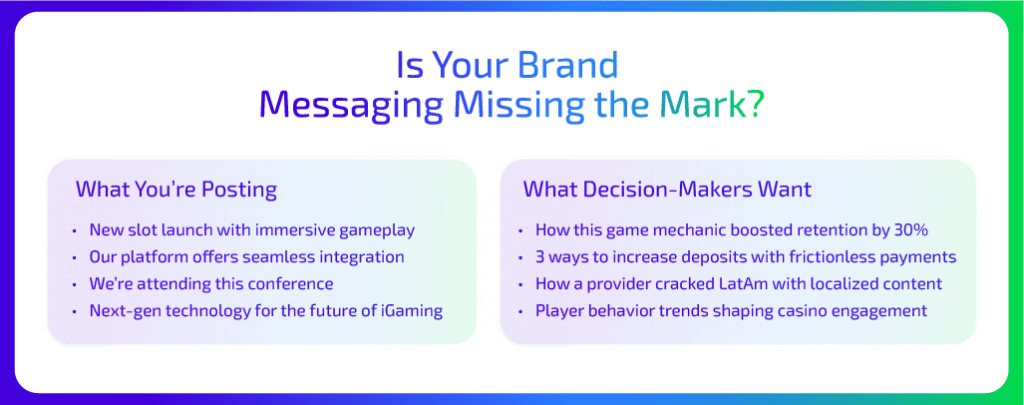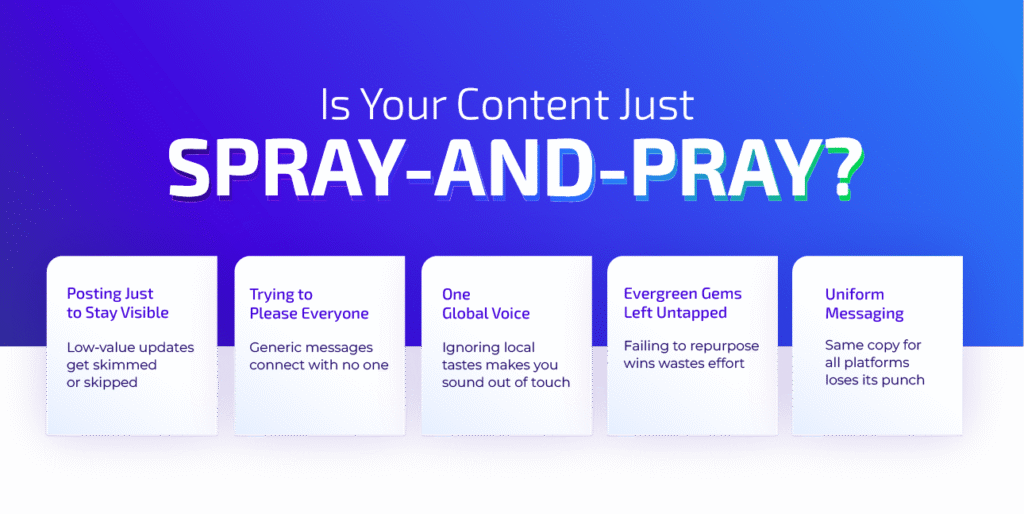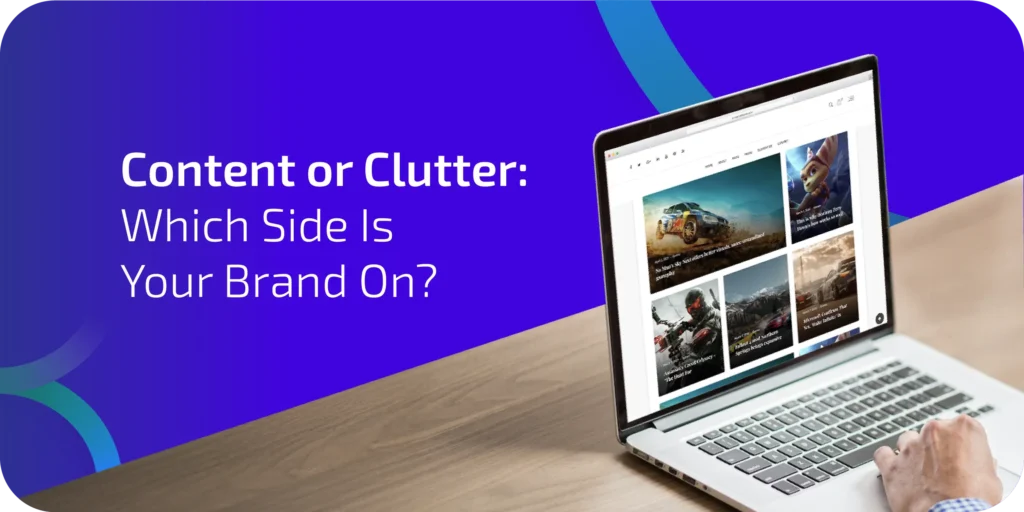Not getting ROI from your iGaming content? If it isn’t driving leads, influencing decisions or generating revenue, what’s it really doing?
iGaming brands push out content daily, but most of it fades without impact. Content that misses the point, misses the audience.
We’ve unpacked why most content gets ignored, what winning brands do differently, and how to create high-converting iGaming content in 2025.
Why Most iGaming Content Fails to Deliver Real Impact

The data shows what most iGaming brands are getting wrong: more content and less impact.
- 46% of B2B marketers plan to increase content budgets in 2025
- But only 29% believe their strategy is effective
Most B2B iGaming content is repetitive, brand-focused and misses the mark. Instead of solving real problems, it gets published, shared and quickly forgotten.
Brands create content based on what they want to say, not what their audience needs to know.
Decision-makers ignore your content because it doesn’t speak to them. When content lacks intent, it loses impact.
So what does effective B2B iGaming content look like in practice?
- A game provider highlighting a new mechanic that improves player retention is speaking directly to operators focused on engagement and revenue.
- A crowdtesting provider that highlights real-device testing catches the attention of game studios focused on early bug detection, retention, and smooth launches.

Expert Tip
Your iGaming content should address audience needs and intent, not just what your brand wants to say, to avoid being ignored.
- Repetitive Content Is Killing B2B iGaming Engagement
- Lack of Differentiation in iGaming Thought Leadership
- Adapting iGaming Content for Each Platform and Audience
Repetitive Content Is Killing B2B iGaming Engagement
Most iGaming content sounds the same. Generic announcements and feature highlights fail to engage decision-makers. When everything feels familiar, even strong products get ignored.
Take slot launches, for example. Claims like “immersive gameplay” or “high RTP” mean little to operators unless you clearly explain what sets the game apart and why it matters. Showcase mechanics that improve retention, bonus structures that boost engagement, or features tailored to regional preferences and emerging play trends.
B2B iGaming businesses, such as PAM platforms and game aggregators, often fall into the same trap. They use terms like “seamless integration” but rarely explain how it helps. Whether it’s speeding up onboarding, reducing dev effort or improving operator reach.
Content must move beyond specs and slogans. It should speak directly to business goals like user acquisition, market growth and regulatory alignment.
Lack of Differentiation in Thought Leadership
Most B2B iGaming service providers fail to offer original perspectives, practical insights or data-backed ideas. To lead with content, you need to provide real value. You must go beyond product pitches to address real challenges, market shifts or regulatory change.
True thought leadership requires a differentiating factor. It could be proprietary data, in-depth market analysis, or real-world case studies that offer value competitors don’t. Without it, brands fade into the background instead of leading the industry forward.
For example, a scalability report from a casino aggregation platform falls flat without fresh data. Insights need to be tied to real operator growth challenges. A KYC testing provider offering generic fraud prevention advice adds no value. It must address risks like duplicate accounts or region-specific compliance gaps.
Adapting Content for Each Platform and Audience
iGaming brands often copy and paste the same content across LinkedIn, email newsletters, and websites without adjusting the messaging. This one-size-fits-all approach weakens engagement and makes content easy to overlook. Decision-makers expect content tailored to how they consume information.

For iGaming Marketing Teams Who Want More
Practical tips, trends, strategies, and more.
Take the topic “Jackpot Fatigue is Real in 2025.”
On LinkedIn, the focus should be on sparking discussion. A carousel post might open with “Are jackpots losing their appeal? Here’s what the data says.” Each slide can highlight trends, player preferences, and reward alternatives, ending with a prompt: “What’s the future of jackpot-driven engagement?”
For a website article, the content needs a deeper, data-backed lens. It should explore why jackpot fatigue is rising, which regions are affected, and how alternative models like mission-based rewards or tiered loyalty programs are performing.
In an email newsletter, the focus should be quick consumption. Instead of summarizing an article, offer exclusive insights like “Operators using mission-based rewards see a 20% lift in long-term retention.”
At the bottom of the funnel, a webinar or panel can turn awareness into action. Operators, game providers, and retention experts can engage in deeper discussion and live interaction.
Rigid Content Plan Costs Leads and Relevance
Your iGaming content strategy should introduce fresh angles, scale what works and adapt based on performance. Sticking to a rigid calendar leads to missed opportunities and lower engagement.
Each month, brands should analyze past performance to double down on high-impact themes while testing new ones. If jackpot content performs well in LatAm but falls short in Africa, double down on what works. Test alternatives like mobile-first or rewards-based engagement.
Likewise, a game testing provider posting general QA tips on LinkedIn might see low traction. But if real-world testing examples drive engagement, they should shift focus and experiment with new formats like carousels comparing manual vs. automated testing. If it works, scale it.
iGaming Content Built for Internal Approval, Not External Engagement

Content that satisfies internal teams often misses the mark with its audience. iGaming brands create content for approval instead of addressing real market challenges. It may be technically accurate but lacks relevance for decision-makers.
PAM platform providers often focus on system architecture, while operators care more about integration speed, platform stability, and how the system supports player experience.
Game providers highlight RNG mechanics, but operators care more about how the game drives engagement and revenue.
When content leads with internal talking points instead of market needs, it fails to deliver value.
Key Summary Points: Prioritize market needs and audience relevance over internal approvals to ensure your iGaming content truly resonates and delivers value.
- Overemphasis on Brand Messaging in iGaming Content
- iGaming Content Without a Voice Has No Influence
- Failure to Address Real Business Challenges in iGaming Content
Overemphasis on Brand Messaging
Is your content focused more on features, partnerships, and milestones than on solving real industry problems? If so, you’re not speaking to what decision-makers actually care about.
When messaging is brand-centric instead of solution-driven, it struggles to engage the target audience.
For example, a game provider posting on LinkedIn about its latest slot release, emphasizing its “unique game engine” fails to explain how it helps operators improve player retention.
Payment provider publishing a whitepaper on fraud prevention is ineffective if it only describes tech and not how it reduces chargebacks or boosts approval rates.
Shift the focus from what you’ve built to what it actually solves. To drive engagement, show how your solution improves profitability, solves pain points and fits into your audience’s goals.
Content Without a Voice Has No Influence
Does your content read like a spec sheet, or does it reflect the voice of someone who understands the industry? Content that lacks personality fails to engage.
B2B iGaming businesses that rely on stiff, technical writing miss the opportunity to connect with industry stakeholders. Decision-makers want insights that challenge thinking, solve real problems and drive action.
Content should sound like it was written by people who understand the industry. And it must speak to those who drive decisions.
Failure to Address Real Business Challenges
iGaming decision-makers want solutions, not feature lists. Decision-makers are looking for partners who understand their challenges.
Content should show how your product solves real problems, improves efficiency and drives revenue.
For example, a game testing provider should go beyond generic QA and explain how region-specific bug detection prevents reworks. Or how real-device testing ensures a smooth player experience.
Where iGaming Content Execution Falls Apart
Even smart strategies fail when execution is rushed or misaligned. From one-size-fits-all messaging to disconnected funnel execution, small missteps can kill performance.
Here’s what’s hurting your content and how to fix it.
One-Size-Fits-All Approach Doesn’t Work

Messaging that tries to speak to everyone connects with no one. Whether you’re segmenting by region or role, content must be tailored to specific business needs and relevance.
iGaming brands operate across diverse markets and decision-maker roles, each with distinct goals and expectations.
A football-themed slot campaign might succeed in Brazil, where players favor high-volatility and sports narratives, but fail in Africa, where mobile-first formats, local themes, and lower bet limits drive engagement. Without adjusting messaging, campaigns miss the mark.
The same applies to audience roles. A crowdtesting provider targeting game studios shouldn’t dilute messaging to appeal to operators. Studios care about performance and integration testing, while operators prioritize compliance, payments, and UX. Trying to reach both with one message results in content that lands with neither.
Content Created Just to “Stay Active”
Posting for visibility without purpose weakens credibility. Content that feels routine or obligatory gets ignored. Decision-makers want insights that solve problems, highlight opportunities, or track market shifts.
Yet many brands fall into the trap of publishing just to stay visible. A game provider posting five title announcements a week won’t hold attention. Instead of repeating releases, they could analyze why certain mechanics boost session length or how regional trends shape content strategy.
One well-researched article with real insights does more to build authority than a flood of empty updates.
Neglecting Evergreen Content
Great content doesn’t always need to be new. Brands often overlook the value of refreshing what already works. High-performing articles, reports and guides can be updated and reused to stay relevant and drive ongoing engagement.
Take this for example. A player behavior report from 2024 can be turned into a 2025 trend piece. Just add updated data on evolving preferences, new mechanics and regional retention patterns.
Or consider a compliance guide. It can be refreshed with Brazil’s latest regulatory updates covering licensing, taxation and operational rules.This kind of comparison helps businesses plan smarter market entries and avoid compliance setbacks. It makes your content more relevant and in demand.
Strategic Content Segmentation
Not all content serves the same purpose. A thought leadership post that sparks discussion doesn’t belong in a whitepaper, just as a technical breakdown won’t engage on LinkedIn. Content should be segmented by funnel stage, platform and how decision-makers consume information.
Top-of-funnel content builds awareness and curiosity. Use LinkedIn carousels to simplify trends like “The Future of Casino Gamification,” highlighting shifts from traditional jackpots to personalized rewards. Blog posts and newsletters can surface industry challenges or spark curiosity without a hard sell.
Mid-funnel content nurtures interest. Interactive quizzes like “Are Your Player Retention Strategies Future-Proof?” offer self-assessment value. Whitepapers, webinars, and reports deepen trust with data and expert context on topics like compliance or engagement.
Bottom-of-funnel content drives decisions with proof. Content pieces like case studies show results, such as a crowdtesting provider helping a game studio reduce time-to-market by 30% by identifying region-specific bugs before launch.
Build a Content Strategy That Earns Trust and Drives Results

Decision-makers don’t want pitches. They want insights that help them make better decisions.
Content should focus on market trends, data-backed insights and real solutions.
So what does that look like in practice? Let’s break it down.
Shift from Product Promotion to Industry Insights
Promotional content gets ignored. Decision-makers want insights that help them stay ahead. Brands that focus on trends, expert analysis and practical strategies build credibility.
Instead of pushing platform scalability, a casino platform provider can analyze how integrating multiple third-party solutions affects system performance and market adaptability.
Leverage Real-World Examples
Proof builds credibility. Industry professionals don’t engage with vague promises. They want to see real outcomes, backed by data and experience.
Real-world results speak louder than generic claims. You need to highlight measurable success.
Instead of saying, “We help operators scale,” a turnkey platform provider could show how its modular setup enabled an operator to launch in three regulated markets within six months. By reducing integration dependencies and streamlining certification workflows, they cut go-live timelines by 30% and unlocked faster revenue.
Drive Engagement Through Strategic Dialogue
Your content should spark discussion, not just broadcast messages. Decision-makers engage with insights that challenge assumptions and invite input.
A LinkedIn post from a game provider questioning whether free spins drive retention or just short-term play will spark more engagement than a standard promo. A poll from a payment provider about friction in payment approvals will prompt more responses than a static post on fraud prevention.
Encouraging dialogue boosts visibility and builds credibility. By sparking meaningful conversations, you position your brand as a leader.
Maximizing Reach Through Strategic Distribution

Great content means nothing if the right people never see it. Brands often invest in creation but overlook strategic distribution and repurposing. A well-placed, well-timed piece has far more impact than a stream of scattered posts.
Smart distribution goes beyond social media. Industry magazines, gaming forums, and iGaming conferences offer visibility where decision-makers already spend time. Targeted emails and media partnerships add scale and relevance.
So how do you tailor content formats to match audience behavior? Let’s break it down.
Expert Tip: Don’t just create; strategically distribute your iGaming content, aligning formats with audience behavior and exploring disruptive approaches to stand out.
Aligning Formats with Audience Behavior
Decision-makers consume content differently. African operators prefer localized, mobile-first formats, while European leaders engage more with detailed reports and thought leadership. Adapting to these preferences drives stronger results.
Brands should refine formats using metrics like watch time, click-throughs and drop-off rates. If long-form content underperforms while infographics or Q&As gain traction, that’s your signal to shift.
For example, a player retention report aimed at African markets could work better as a mobile-friendly infographic or a short LinkedIn video. Meanwhile, European stakeholders evaluating platform security may prefer a whitepaper comparing compliance frameworks and risk protocols.
Testing and adapting content formats keeps messaging relevant, digestible, and decision-ready.
The Need for Disruptive Content Strategies
In a sea of sameness, standing out takes bold and insight-driven content. Most brands blend in because their messaging is recycled and uninspired. To capture attention, you need stories that challenge expectations and spark curiosity.
At iCatalyft, we engineer strategic narratives that move the right people to act. We turn deep industry insight into messaging that builds authority, drives conversions and earns lasting trust.
If you’re serious about impact, we’re serious about helping you get there.
The Bottom Line
- Build messaging around real audience pain points and decision intent
- Replace brand-led narratives with insight that moves the buyer forward
- Tailor format and depth to where the user is in their journey
- Distribute with purpose across channels your audience already trusts
- Prove value through outcomes your stakeholders care about
FAQs: B2B iGaming Content Strategy
How can iGaming brands generate qualified leads through content?
Create content around real challenges like market trends, compliance shifts, and user behavior. Map format and messaging to the decision-making journey.
What content builds trust in B2B iGaming?
Show proven results, market-specific insights, and clear business outcomes. Add licensing details, expert input, and use cases that align with stakeholder goals.
What’s the best format for B2B iGaming thought leadership?
Use carousels and insights for awareness, whitepapers for trust and case studies for conversions. Match each format to user intent and funnel stage.
How should iGaming brands localize content for different markets?
Go beyond translation. Tailor messaging to region-specific pain points like mobile adoption, regulation, and player preferences.



